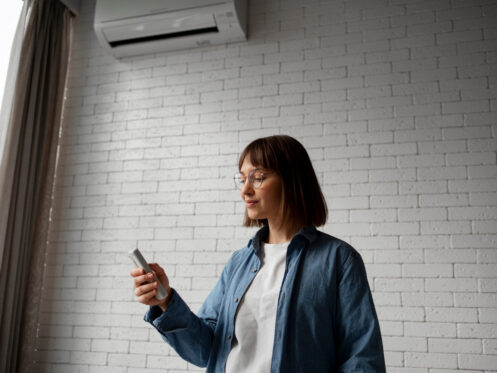When temperatures soar in Lancaster, a working air conditioner is key to keeping your home cool and comfortable. That’s why having a reliable AC remote control matters. It’s the tool most homeowners rely on day-to-day to adjust settings, switch modes, and maintain the right indoor climate without ever needing to get up. But like any battery-operated device, remote controls can run into issues, especially during heavy-use seasons like summer.
If your AC unit isn’t responding or is behaving strangely, the problem could be as simple as a remote control malfunction. Homeowners often overlook the remote when troubleshooting cooling problems, jumping straight to assumptions about the HVAC system itself. Before you call in for a full inspection, it’s worth checking whether your controller is the real issue. A few basic steps can save time, prevent unnecessary service calls, and help keep your system performing the way it should.
Common AC Remote Control Problems
AC remote controls may not be complicated devices, but when they stop working properly, it can be frustrating. Most problems are minor but still affect how well your cooling system operates.
Below are the most common issues that homeowners in Lancaster run into when using their AC remotes:
– No response when buttons are pressed. This usually points to a battery issue or signal failure.
– Lagging or skipping commands. Sometimes the AC responds late or not at all to the remote. This could indicate wear on the buttons or internal malfunctions.
– Unresponsive buttons. Specific buttons may stop working altogether, making it impossible to change the temperature, switch cooling modes, or adjust fan speed.
– Blank or faded display. If your LCD screen is hard to read or blank, it can make using the remote difficult.
– Inconsistent operation. The remote works one moment and not the next. Inconsistency can make it hard to trust and use daily.
Even a small problem with the remote can cause inconvenience. For instance, if the mode button stops working, you may become stuck in a setting that’s too warm or too cold for your needs. That inconvenience quickly grows when the weather outside hits peak summer heat in Lancaster. By identifying these common problems early, you can better determine whether it’s time for a battery swap, a reset, or support from a professional.
Step-by-Step Troubleshooting Guide
Before assuming the worst, try diagnosing the remote with a few straightforward steps. Most remote control issues can be traced back to the battery, signal interference, or the need for a reset.
Here are four steps you can take to troubleshoot remote control issues yourself:
1. Check the Batteries: Dead or dying batteries are the easiest fix and the most overlooked. Replace both batteries with fresh ones of the correct type. Make sure they’re installed in the right direction. Once inserted, test a few buttons to see if the response improves.
2. Test for Functional Response: Some remotes have a test mode or reset button. If yours does, try using this to verify whether the remote is still functioning. Even without a test mode, you can use a smartphone camera to check if the infrared signal is being sent. Point the remote’s infrared end at the camera and press a button. If you see a flash on your phone screen, the signal is being transmitted.
3. Check the Signal Path: Make sure nothing is blocking the line between the remote and the AC unit. If furniture, curtains, or electronics are in the way, the signal might not reach the receiver properly. Test again with an unobstructed path. Get close enough to the unit while pressing buttons, especially if distance is affecting performance.
4. Reset the Remote: If the buttons seem nonfunctional or the display has frozen, a full reset might help. Remove the batteries, press and hold the power button for about 10 seconds, and then reinsert the batteries. This process can sometimes clear out minor internal glitches.
If none of these steps resolve the issue, there may be a deeper problem either within the remote or the AC unit’s receiving sensor. In that case, professional evaluation is the next step.
When to Call for Professional Help
If the AC remote still is not working after trying all the basic steps, there may be a larger issue. Sometimes, the problem is not within the remote at all but with the air conditioner itself. The receiver in the indoor unit could be malfunctioning, or there could be a wiring issue that blocks signal transmission. It is also possible that water exposure or long-term wear has damaged internal components beyond what a reset can fix.
These types of problems usually require the tools and knowledge of trained technicians. For example, if the system turns on and off directly from the unit, but not with the remote, then the issue is likely with the internal receiver or signal processing. These are not issues that can be fixed with battery replacements or repositioning the unit.
Our professionals can quickly identify whether the issue lies with the remote control, the indoor control board, or another part of the system. If a new remote or receiver repair is needed, our technicians will walk you through the available solutions so your home does not go without cooling longer than necessary.
Tips for Long-Term Remote Control Care
To avoid running into recurring remote control problems, taking care of the device is important. Small actions now can help prevent bigger issues later.
Here are some easy habits for long-term AC remote health:
– Keep the remote dry. Avoid using it near open windows or in rooms with high humidity unless it is clearly moisture-resistant.
– Wipe it down gently with a soft, dry cloth to prevent dust buildup on sensors and buttons.
– Do not drop the remote or place heavy objects on it. Impacts and pressure can damage internal components or make buttons stick.
– Store the remote in the same place daily. This helps prevent misplacing it and reduces the chance of physical damage.
– If you do not plan to use the AC for a while, like during the winter, remove the batteries. This prevents corrosion from harming the device.
With regular care, your AC remote can stay responsive and reliable through Lancaster’s hottest months.
Keeping Your AC System in Peak Condition
A remote control that fails to function the right way can reduce the usability of your entire AC system. When temperatures rise and you need quick adjustments to fan speed or cooling modes, a faulty remote quickly becomes more than a small issue.
The health of every component, including the remote control, impacts how well your AC delivers comfort through the summer. That is why it is wise to schedule routine AC maintenance in Lancaster. When our professionals inspect your equipment, they do not just look at the unit but also catch small problems that can cause performance trouble later. A malfunctioning remote can often point to larger system issues like failed receivers or signal blockages, which our team is trained to identify and fix.
Staying on top of AC maintenance not only improves system efficiency but also protects you from last-minute breakdowns. An experienced technician can help ensure your cooling runs well and that your remote control remains effective all season long. From checking batteries to testing infrared signals and replacing damaged remotes, our technicians are ready to support however you need. Regular checkups help avoid guesswork and ensure consistent comfort inside your home during Lancaster’s summer heat.
If you are a homeowner in Lancaster experiencing issues with your AC remote control or suspect that your cooling system needs a closer look, scheduling AC servicing in Lancaster is a smart way to ensure everything is functioning as it should. Trust Affordable Air Inc. to deliver dependable service and expert support to keep your home comfortable all season long. For a quick estimate or to book a service visit, please contact us today.




